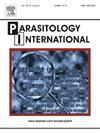中国蛇类肠杆菌遗传多样性的出现。
IF 1.5
4区 医学
Q3 PARASITOLOGY
引用次数: 0
摘要
肠孢子虫属于小孢子虫门,是一种寄生虫,据报道可感染各种家畜、野生动物和人类,从而引起以严重或慢性腹泻和吸收不良为特征的肠道疾病。典型的传播途径是受污染的水和食物。关于爬行动物感染 E. bieneusi 的研究报道很少,然而,我们的报告侧重于中国蛇类感染 E. bieneusi 的分子特征。我们共收集了 603 份中国蛇类的粪便样本。我们通过 PCR 扩增内部转录间隔位点(ITS)来检测样本中是否存在 E. bieneusi。我们的分析表明,E. bieneusi的总体感染率为15.59%,感染率最高的是东方鼠蛇(21.99%),其次是玉米蛇(19.63%),而普通带绦蛇、松树蛇和细鳞蛇的感染率分别为18.39%、15.79%和13.56%。东方王蛇的感染率最低,仅为 5.71%。基因型分析确定了 26 种不同的基因型:8 个已知基因型和 18 个新基因型。系统发育分析表明,25 个基因型属于第 1 组,其中包括来自不同动物宿主和人类的分离株。我们的研究表明,宠物蛇是中国人畜共患微孢子虫病的潜在传播源之一。本文章由计算机程序翻译,如有差异,请以英文原文为准。

Emergence of genetic diversity of Enterocytozoon bieneusi from snakes in China
Enterocytozoon bieneusi belongs to the phylum Microsporidia, a parasite reported to infect various domestic animals, wildlife and humans, thereby causing an intestinal disease characterized by severe or chronic diarrhea and malabsorption. The typical mode of transmission is contaminated water and food. Few studies on E. bieneusi infections have been reported in reptiles, however, our report focuses on the molecular characterization of E. bieneusi infection in snakes in China. We collected a total of 603 fecal samples from snakes in China. The samples were tested for the presence of E. bieneusi through PCR amplification of the internal transcribed spacer (ITS) locus. Our analysis showed E. bieneusi overall prevalence rate of 15.59 %, the highest prevalence was recorded in Eastern rat snake (21.99 %), followed by Corn snake (19.63 %) while the prevalence of 18.39 %, 15.79 %, 13.56 % were recorded in Common garter snake, Pine snake, Hognose snake respectively. Eastern kingsnake has the lowest infection rate of 5.71 %. Genotype analysis identified 26 distinct genotypes: 8 known and 18 novel. Phylogenetic analysis revealed that 25 genotypes belonged to Group 1, which includes isolates from various animal hosts and humans. However, genotype GX29 was classified under Group 9. Our study indicates that pet snakes are one of the potential sources of transmission of zoonotic microsporidiosis in China.
求助全文
通过发布文献求助,成功后即可免费获取论文全文。
去求助
来源期刊

Parasitology International
医学-寄生虫学
CiteScore
4.00
自引率
10.50%
发文量
140
审稿时长
61 days
期刊介绍:
Parasitology International provides a medium for rapid, carefully reviewed publications in the field of human and animal parasitology. Original papers, rapid communications, and original case reports from all geographical areas and covering all parasitological disciplines, including structure, immunology, cell biology, biochemistry, molecular biology, and systematics, may be submitted. Reviews on recent developments are invited regularly, but suggestions in this respect are welcome. Letters to the Editor commenting on any aspect of the Journal are also welcome.
 求助内容:
求助内容: 应助结果提醒方式:
应助结果提醒方式:


